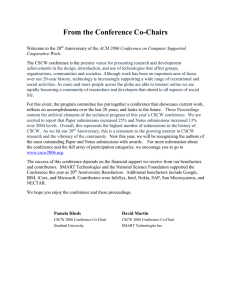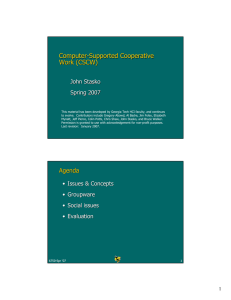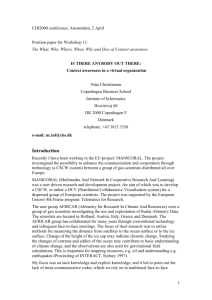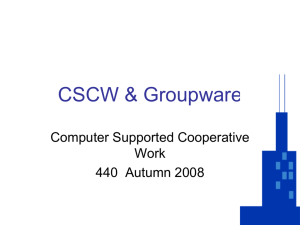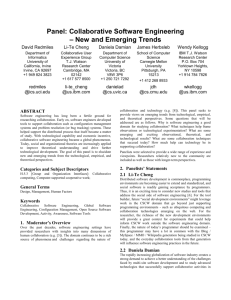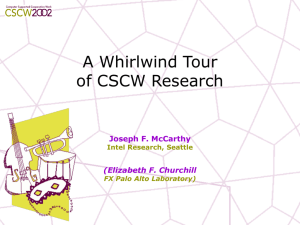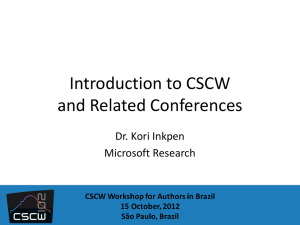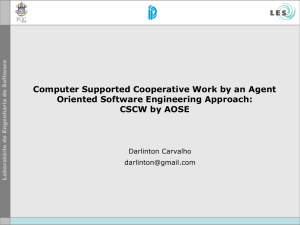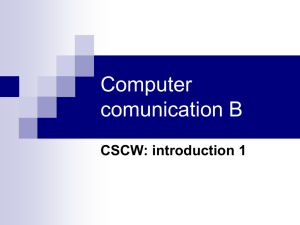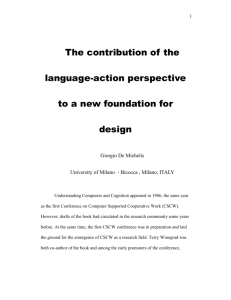CSCW ‘86 Conference Summary Report T Herb Krasner
advertisement
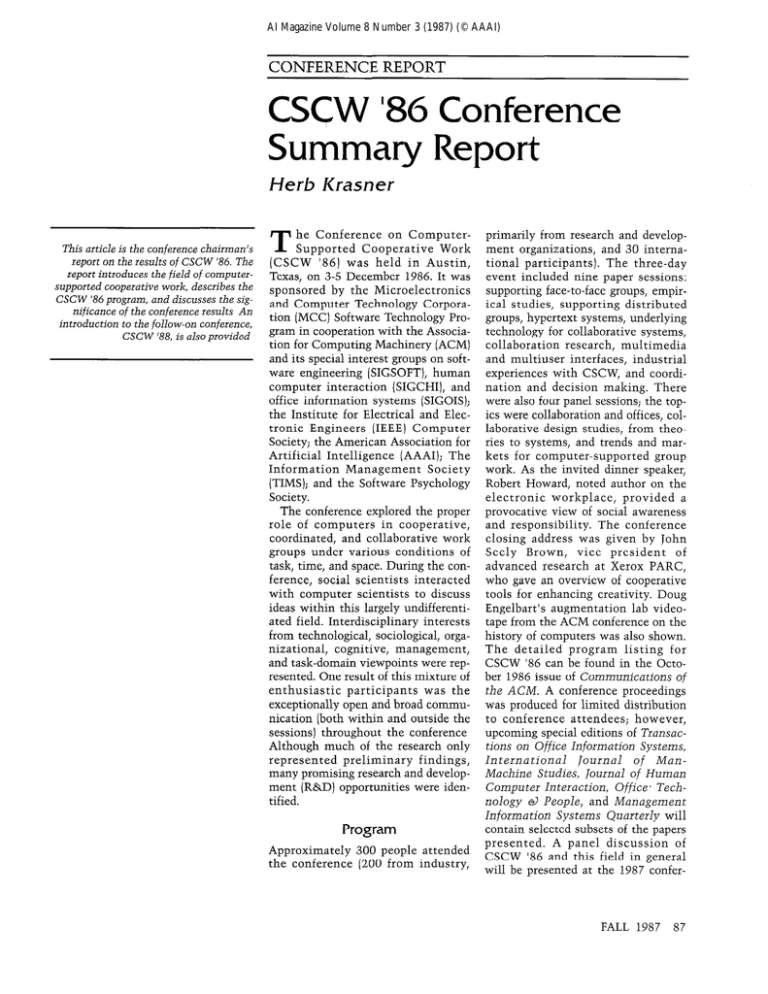
AI Magazine Volume 8 Number 3 (1987) (© AAAI) CONFERENCE REPORT CSCW ‘86 Conference Summary Report Herb Krasner This article is the conference chairman’s report on the results of CSCW ‘86. The report introduces the field of computersupported cooperative work, describes the CSCW ‘86 program, and discusses the significance of the conference results An introduction to the follow-on conference, CSCW ‘88, is also provided T he Conference on ComputerSupported Cooperative Work (CSCW ‘86) was held in Austin, Texas, on 3-5 December 1986. It was sponsored by the Microelectronics and Computer Technology Corporation (MCC) Software Technology Program in cooperation with the Association for Computing Machinery (ACM) and its special interest groups on software engineering (SIGSOFT), human computer interaction (SIGCHI), and office information systems (SIGOIS); the Institute for Electrical and Electronic Engineers (IEEE) Computer Society; the American Association for Artificial Intelligence (AAAI); The Information Management Society (TIMS); and the Software Psychology Society. The conference explored the proper role of computers in cooperative, coordinated, and collaborative work groups under various conditions of task, time, and space. During the conference, social scientists interacted with computer scientists to discuss ideas within this largely undifferentiated field. Interdisciplinary interests from technological, sociological, organizational, cognitive, management, and task-domain viewpoints were represented. One result of this mixture of enthusiastic participants was the exceptionally open and broad communication [both within and outside the sessions) throughout the conference Although much of the research only represented preliminary findings, many promising research and development (R&D) opportunities were identified. Program Approximately 300 people attended the conference (200 from industry, primarily from research and development organizations, and 30 international participants). The three-day event included nine paper sessions: supporting face-to-face groups, empirical studies, supporting distributed groups, hypertext systems, underlying technology for collaborative systems, collaboration research, multimedia and multiuser interfaces, industrial experiences with CSCW, and coordination and decision making. There were also four panel sessions; the topics were collaboration and offices, collaborative design studies, from theories to systems, and trends and markets for computer-supported group work. As the invited dinner speaker, Robert Howard, noted author on the electronic workplace, provided a provocative view of social awareness and responsibility. The conference closing address was given by John Seely Brown, vice president of advanced research at Xerox PARC, who gave an overview of cooperative tools for enhancing creativity. Doug Engelbart’s augmentation lab videotape from the ACM conference on the history of computers was also shown. The detailed program listing for CSCW ‘86 can be found in the Octoof ber 1986 issue of Communications the ACM. A conference proceedings was produced for limited distribution to conference attendees; however, upcoming special editions of Transactions on Office Information Systems, International /ownal of ManMachine Studies, Tournal of Human Computer Interaction, Office. Technology eQ People, and Management Information Systems Quarterly will contain selected subsets of the papers presented. A panel discussion of CSCW ‘86 and this field in general will be presented at the 1987 confer- FALL 1987 87 ence on Human Factors in Computing Systems and Graphics Interface. Several related activities occurred around the conference setting. These activities included a meeting (at MCC) of researchers interested in augmented meeting technology, a miniworkshop (at MCC) on hypertext system developments, and a local meeting of the Computer Professionals for Social Responsibility (CPSR) society (at the University of Texas). Participating Research Institutions Highlights from the program identify major research institutions pursuing the research area of computer-supported cooperative work. Those groups represented several times in the program were Xerox PARC, the Massachusetts Institute of Technology (MIT), Stanford University, MCC, the Rand Corporation, and the University of Southern California (USC). Xerox PARC was the most heavily represented research institute at CSCW ‘86. Members presented “The Cognoter Tool of the Colab Project” (G Foster and M. Stefik), “Organizational Impact Studies” (J. Blomberg), “Anecdotal Narratives as Cooperative Diagnostic Activity” (J. Orr), “Collaboration in Notecards” (R Trigg, L Suchman, and F. Halasz), “A Study Paradigm for Collaboration” (L. Suchman and R. Trigg), “Remote Collaboration Research in the Systems Concept Lab” (G. Goodman and M. Abel], “WYSIWIS Experiences” (M. Stefik et al.), Enhancing Creativity with Collaboration Tools (J Seely Brown), and “Design Media Space Research” (M. Harrison) MIT presentations were “A Case Study of Computer Conferencing” (K. Crowston, T. Malone, and T Lin), “Semi-Structured Messages for Coordination” (T. Malone et al.), “Data Sharing” (I Greif), “Office Automation Implications” (C. Hewitt], and” From Theories to Systems” (T. Malone). Stanford presentations were “A Language Perspective on CSCW” (T. Winograd), “Understanding Group Conceptual Design” (J. Tang), “A Performing Media for Working Group Graphics” (F. Lakin), and “Experiment in Integrated Multi-Media Conferencing” (K. Lantz) 88 AI MAGAZINE Presentations from MCC were “Nick, The Augmented Meeting Lab” (C. A Ellis et al.), and “Empirical Studies of Cooperative Design Process” (B. Curtis and H. Krasner). RAND presentations were “Empirical Assessment of Communication Networks” (J. Eveland and T Bikson) and !‘Experiences in a Federal Agency” (C. Stasz and T. Bikson). Finally, the presentations from USC were “System Factory Project” (W. Scacchi) and “Goal/Term Sharing for Cooperation” (R. Neches). Other organizations represented in the program were the University of Arizona (L. Applegate et al.), the University of Michigan (M. Feldman), Brown University (L. Garrett et al.), IBM (N Jarrel and B. Barrett), Bellcore (R Kraut et al.), Digital Equipment Corporation (P. Cashman and D. Stroll), Institute for the Future (R. Johansen), Hewlett-Packard (T. Fanning and B. Raphael), the University of Milan0 (F. DeCindio et al.), Aetna (B. Johnson et al.), the University of California at Irvine (K. Kraemer and J. King), New York University (M. Olson and K Lowe), the University of Texas (G Huber), and the University of Maryland (B. Shneiderman). Results I collected data about impressions of the conference’s value, the conference concept, suggestions for improvement, conference logistics, and so on, through an evaluation sheet. The important points on the technical content of the conference are summarized here See the 32d edition (December 1986) of Release 1.0 (the newsletter of EDventure Holdings Inc.) for another insightful view of what happened at CSCW ‘86, especially as it related to software development. Attendees rated the conference high (average score of SS/lOO) primarily because of the enthusiastic group in attendance and the interest in the topic. However, some individuals felt that certain concerns were not represented at the conference (for example, organization designers, commercial product people, and “real workers” from big companies) and that CSCW in research settings was overempha- sized Some participants thought the name of the conference was too restrictive (that is, emphasis should be on coordination and communication with a special emphasis on joint social and computer science research), and those persons newly involved wanted a historical context (the Engelbart tape made the slow progress obvious however) and tutorial information. Empirical studies of big organizations and theoretical foundation work was desired. Computer support for CSCW was obviously missing, and suggestions for online proceedings and ongoing computer-supported conferencing were made. Several people said that there was not enough controversy in the program. This statement leads me to conclude that perhaps the attendees were too cooperative; although some consensus on major issues from this emerging field occurred, several viewpoints were not represented, and therefore, some aspects were not discussed (for example, hostile environments, conflict resolution, assumption surfacing, and so on). Nonetheless, CSCW ‘86 was a watershed (J. Seely Brown’s term) event, pulling together the best research in this new, emerging field. The questions that arise in my mind based on what occurred at CSCW ‘86 are, what are the next steps in this field? and what is the “value added” of technologies explored and presented relative to the needs of working groups in a changing society headed into the twenty-first century? Possibly these and other questions will be discussed at the follow-on conference planned for fall 1988. The CSCW’88 conference planning committee includes Irene Greif, chair; Lucy Suchman, program chair; Najah Naftah, international representative; Herb Krasner, past chair; and George Goodman, local arrangements chair. CSCW’88 will be held in Portland, Oregon, 26-28 September 1988. A call for papers announcement or additional conference information can be obtained from Suzanne Sylvia at (617) 2251860.
